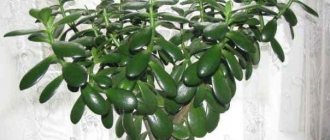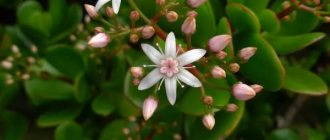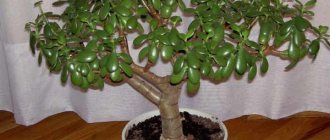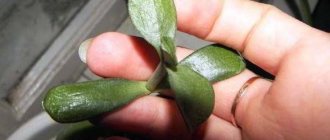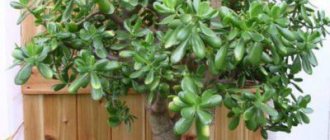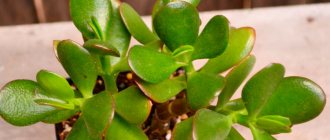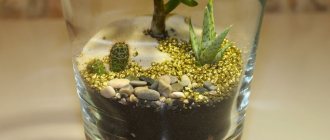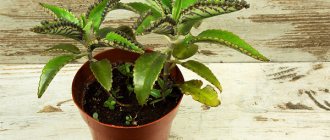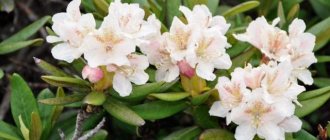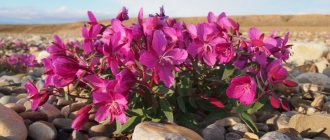Botanical description
Most species of Crassula are perennial plants with pronounced properties of succulents (they can accumulate water and nutrients not only in the roots, but in the trunk and leaves).
The root system of the plant is branched, but covers only the upper layers of the soil. Crassula can do without water for a long time, however, when the soil is sufficiently damp, the root shoots actively consume all the moisture from it, accumulating it in the trunk and leaves of the plants.
The leaves of Crassula are usually oblong, round in shape, located oppositely along the length of the trunk and shoots. They are fleshy and have the ability to retain moisture and microelements in their tissues for a long time (even better than the root or trunk). The leaf color of most varieties is dark green, but light green, pale gray, silver and even red are found. Sometimes the leaves of some varieties have two colors: for example, the border is red, and the main plate is classic green. The size of the plates most often does not exceed 5 cm, but there are species with leaves more than 10 cm in length and 4-5 cm in width.
The Crassula bush can grow up to 3-4 m in height. However, decorative species for indoor cultivation are usually much smaller (15-20 cm).
IMPORTANT! Crassula is known as a poisonous plant. The thing is that in the wild it accumulates a lot of arsenic in its leaves, drawing it from the soil. Indoor varieties are, of course, less harmful, since limited amounts of soil usually contain little arsenic. True, they can also cause allergic reactions or mild poisoning if the juice gets into the mouth or mucous membranes of a person.
The flowers of the plant are less often single, and more often collected in small racemes. In color there are white, yellow, and very rarely red and blue flowers. It is extremely difficult to achieve flowering at home.
Crassula flowering
Plant structure
The money tree is slightly different in its structure from similar plants that are capable of storing large amounts of water in their tissues (succulents).
Roots
Most succulents have a fairly simple and shallow root system. The root is only one of many mechanisms for storing moisture, but not the most important of them.
In this regard, the root system of Crassula consists of a central rhizome, extending to a shallow depth, as well as numerous lateral shoots, most of which lie only 3-4 cm deep in the soil. In a number of species, aerial root shoots can be found.
Due to such underdevelopment of the root system, Crassula has difficulty surviving every transplant. However, this procedure cannot be avoided, because the flower grows quickly.
Another big problem is that the root system is not always able to firmly hold adult Crassulas, as they become large in size. Because of this, you should carefully select a flower pot: it must be strong, large and heavy.
Crassula root system
INTERESTING . The older the money tree, the more woody its main root becomes and the easier it is to survive transplants.
Leaves
Crassula foliage is the most important component of the plant, determining its identity . It is because of them that the flower largely received its more famous name - the money tree. They also serve as the plant’s most important tool for accumulating moisture, as well as useful micro- and macro-compounds in case of prolonged drought.
The leaves of Crassula are fleshy, dense, often small than vice versa. Most varieties cannot boast of large leaves (they reach only about 5 cm in length), but they always grow so tightly together that they form a neat and extremely attractive crown. Their surface is covered with a waxy coating.
The color of the foliage differs on the outside and back. Usually the inside is decorated with pinkish spots, which can even occupy the entire lower plate.
Crassula leaves
Important! An integral part of the beautiful and correct formation of the Crassula crown can be called pinching the shoots. In this case, the classic growth of the flower occurs in the form of a green dense ball.
Flowers
Flowering of Crassula indoors is a rather rare phenomenon, but it also happens. Most varieties bloom with soft white or light yellow flowers. However, the shades may be different, albeit in a few cases.
On the other hand, if flowering is achieved, then almost the entire crown of the plant is dotted with small single flowers (1-2 cm in diameter) or panicles of inflorescences.
One of the characteristic features of Crassula is its persistent, fragrant aromas when flowering.
The plant blooms for the first time late, usually not earlier than 10 years of age . But then flowers can appear every year (and with less frequency, but only if the flower is poorly cared for). The period of appearance of flowers occurs mainly in late autumn or winter, but it also happens in spring. If the plant is cool (not higher than +18С), then flowering can last up to 3 months in a row.
Money tree flowers
Fruit
The fruits of Crassula, in which the seeds ripen, are multileaflets (or collective leaflets). They are formed not in place of flowers and inflorescences, but in special formations on the stem. They are leathery, dry pericarps with seeds that ripen along the seam.
They are practically never found in captivity.
Money tree fruit
Legends about the flower or why it is called the “Money Tree”
The most common name for Crassula is “money” or also “dollar” tree. This epithet has taken root because the leaves of the plant resemble coins , and they have always been a symbol of wealth and success.
According to another version, the association of a fat wallet, and therefore prosperity, is caused by the trunk of the plant. This flower is thick and dense.
In many ways, all known theories are also supported by the fact that Crassula is a succulent plant, that is, it has the ability to accumulate moisture and nutrients in the roots, leaves, and trunk. That’s why people associate this plant’s ability to collect and preserve what is most important to them with signs about luring money into a wallet with a flower and accumulating wealth.
THIS IS INTERESTING. Particularly superstitious people, even when planting a money tree cutting or replanting a plant, put a coin in the pot for good luck. Sometimes coins are hung on the shoots of the Crassula.
You can also turn to ancient legends. Thus, the money tree was brought back to Ancient China. In this centuries-old culture, the flower was treated with care, they believed that with its energy it brings abundance, wealth, and success.
More interesting beliefs associated with the flower can be found in our article “What signs and superstitions about the “Money tree” (crassula) do you know? Can the plant be kept at home?
Where to buy a beautiful potted plant for growing at home?
You can purchase Crassula at plant nurseries or garden centers in your city. Online shopping can be a good alternative, but you need to pay special attention to the delivery method.
Little Crassula. Photo used as illustration. Source: Yandex.Images
It's best to receive a plant as a gift from a close friend or take a leaf from someone you know's tree and then germinate it. For more information on how to germinate and care for Crassula, read the materials below or follow the links provided in this article.
Flower varieties
Crassula is very common in home floriculture (according to some versions, it is one of the five most popular flowers). For this reason, dozens of completely different species are grown indoors. Some of them are more popular than others.
Crassula Oval
The most common variety for cultivation outside the wild . The strengths of this Crassula are its amazing unpretentiousness to lighting and watering, a wide variety of colors and shapes of foliage.
Perhaps the most common are leaves with a reddish border, although plants with silvery foliage (in fact, light green with a silvery tint) - even more reminiscent of coins - are gaining more and more followers.
Tree Crassula
Tree varieties are decorative, neat, attractive. These qualities are valued in them first and foremost. Secondly, Tree Crassula is also distinguished by its relative unpretentiousness.
In captivity, this species rarely blooms.
Plant care
Crassula can be safely and quite reasonably called an extremely unpretentious plant , which can be left without watering for quite a long time, fed occasionally, and even placed in a dark place.
On the other hand, with proper care and recreation of ideal temperature conditions, the flower will always look its best, and in some cases it will even bloom, which in itself can be called an amazingly beautiful, but rare phenomenon.
First of all, it is important to remember that Crassula is a guest from warm places. Therefore, it needs a lot of heat and more light (but always diffused). The plant perceives the absence of other conditions relatively calmly.
Temperature and lighting
It is worth knowing that Crassula usually grows in the shade of the jungle or on the slopes of mountains and hills. This means that she does not like direct and constant sunlight. It is better for the plant to be located in shaded areas where there is a minimum of direct sun. It is believed that the ideal location is: balconies (but not on the windowsill), western and eastern windows of the premises.
IMPORTANT POINT. Crassula does not tolerate dust on the leaves, so it is recommended to periodically wipe the plant with a damp cloth or even treat it with a cool shower.
Air temperature is another important thing to monitor. The fat woman prefers a temperature background in the range of +15-20С . But it is important to remember:
- It is advisable not to allow temperatures above +25С for a long time.
- In winter, any temperature drop below +10С is dangerous.
By the way, you can understand that Crassula doesn’t like something in terms of temperature or light by looking at her condition. Under unfavorable conditions, the lower rows of leaves begin to fall off, and the trunk also becomes significantly thinner.
Watering
The main rule for all succulents is to never overwater them! Otherwise, this will lead to a painful appearance of the flower and rotting of the root system.
That is why the soil for Crassula must have 3-5 cm of drainage at the bottom, as well as holes for draining excess moisture.
TIP : It is not recommended to water the money tree with tap water. It is better to use water that has stood for 1-2 days or collected after rains.
Crassula consumes moisture through both roots and leaves. Given this feature of the flower, it must not only be watered well (but do this no more than 1-2 times a week), but also regularly sprayed and wiped with damp wipes or rags.
There are no uniform standards; it all depends on the air temperature and humidity established in the room. It is best to monitor the earthen clod and water the plant every time it dries to a depth of 4-5 cm.
More information in our article “Secrets of watering the “Money tree” (crassula).”
Soil, fertilizing, replanting
Crassulas are not picky about soil quality. They can grow even on very poor sandy soils (this is what happens in the wild). Therefore, for them you can give preference to a mixture of leaf and turf soil, purchased soil for cacti or succulents.
The money tree needs to be replanted about once a year, as it grows. Each next pot should be 5-6 cm larger in diameter than the previous one.
As for fertilizing, Crassula will easily grow without it. On the other hand, it would be a good idea to add mineral mixtures at least once a year during transplantation to reduce the impact of stress from this process.
Read more about growing Crassula in an apartment in our article “How to properly care for the Money Tree (Crassula).”
Reproduction
There are two ways to propagate a money tree:
- Seeds
- By cuttings
Seeds are an extremely unpopular type of propagation for the Crassula. You need to buy them in a specialized store, because collecting the material yourself is impossible due to the fact that crassula does not bloom in apartment conditions
When cutting, the leaf is placed in water so that it produces roots. You can add coal to prevent the cut from rotting and to take root faster. You can root it straight into the ground, but you will have to wait longer for the results.
If the first method is chosen, then after the leaf has given roots, it is planted in a separate pot in prepared soil. Water the young fat plant once a day and make sure that the plant does not freeze. This way adaptation will take place quickly, and the flower will take root well.
Conclusion
Crassula or money tree is an unpretentious plant that is perfectly adapted to growing indoors. Perhaps it has many other advantageous points: it is very easy to care for, today there are a large number of varieties that are very different in appearance, and finally, legends are associated with it about attracting success and financial well-being to the owner.
Perhaps all of the above are the main qualities for which so many people want to keep a money tree in their home. In fact, they certainly won’t have any more inconveniences associated with care, but a beautiful flower will appear in the house and with it positive energy to attract wealth (after all, entire generations of Chinese could not have been wrong, right?).
Problems of keeping the Crassula
As a rule, problems arise when plant care either stops altogether, or it is not proper, and sometimes excessive.
The tree can shed its leaves at any time, which will indicate that there is no moisture at all or the tree has been watered with cold water. Water for irrigation should be at room temperature and not lower, and maybe several degrees higher.
You need to be especially careful when maintaining a tree in winter. During this period, it is very difficult to guess how much moisture it needs. If there is excess moisture, the leaves may wilt or turn pale, and if there is no moisture at all, they may darken, wrinkle and lose their shine.
Damaged leaves should be removed immediately and think about what happened: either watering should be stopped altogether, or watering should be done at least once. If an error occurs in one direction or another, then the money tree can be lost forever.
